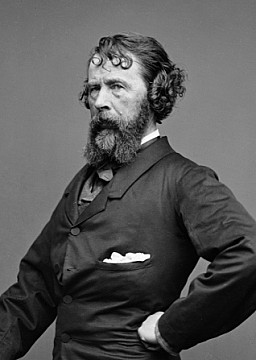Nathaniel Parker Willis (1806-1867)
N.P. Willis, Author, Poet, Editor & the Highest-Paid Magazine Writer of his Day

Father
He was born in Portland, Maine. He was the son and grandson of newspaper publishers in Boston and in childhood George Lunt recalled that he was, "a great favourite with Mrs Harrison Gray Otis, the social leader of her day". He studied at the Boston Latin School and the Phillips Academy, Andover, before graduating from Yale (1827) where his interest in literature began. He started his career publishing poetry and in 1831 moved to Europe as the foreign editor and correspondent for the New York Mirror. In Paris, William Cabell Rives attached him to his Legation, "and it was with diplomatic passport and privilege that he made his way leisurely to the different courts and capitals of Europe and the East, having entrée everywhere to the highest circles."
Having got married in London in 1835 he returned to the States in 1837 and settled at "Glenmary," a small estate of 200-acres that he named for his wife in Oswego County, New York, and from where he wrote Letters from under a Bridge. In 1839, his play Tortesa, the Usurer premiered in Philadelphia which Edgar Allan Poe said was, "by far the best play from the pen of an American author". In 1842, he moved to New York City to better promote his literary reputation and he quickly became the highest-earning magazine writer in America earning $5-10,000 a year so that even Longfellow was jealous. There, he was part of the "Knickerbocker Group", which also included among others Fitz-Greene Halleck, Washington Irving, William Cullen Bryant, James Kirke Paulding, Gulian Crommelin Verplanck, Robert Charles Sands, Lydia M. Child, and Joseph Rodman Drake.
In 1846, he commissioned and worked with Calvert Vaux to create his new home on the Hudson River, Idlewild, which was the direct inspiration for his book, Out-Doors at Idlewild (1855). 1846 also saw him start his own publication that he edited until his death, the Home Journal, that was eventually renamed Town & Country and is still published under that title today. He used it to pay special attention towards promoting the works of female poets such as Frances Sargent Osgood, Anne Lynch Botta, Grace Greenwood, and Julia Ward Howe. As his health diminished, he lived the rest of his life at Idlewild where he died in 1867. His pallbearers included Henry Wadsworth, Longfellow, James Russell Lowell, Oliver Wendell Holmes, Samuel Gridley Howe, and James T. Fields.
Having got married in London in 1835 he returned to the States in 1837 and settled at "Glenmary," a small estate of 200-acres that he named for his wife in Oswego County, New York, and from where he wrote Letters from under a Bridge. In 1839, his play Tortesa, the Usurer premiered in Philadelphia which Edgar Allan Poe said was, "by far the best play from the pen of an American author". In 1842, he moved to New York City to better promote his literary reputation and he quickly became the highest-earning magazine writer in America earning $5-10,000 a year so that even Longfellow was jealous. There, he was part of the "Knickerbocker Group", which also included among others Fitz-Greene Halleck, Washington Irving, William Cullen Bryant, James Kirke Paulding, Gulian Crommelin Verplanck, Robert Charles Sands, Lydia M. Child, and Joseph Rodman Drake.
In 1846, he commissioned and worked with Calvert Vaux to create his new home on the Hudson River, Idlewild, which was the direct inspiration for his book, Out-Doors at Idlewild (1855). 1846 also saw him start his own publication that he edited until his death, the Home Journal, that was eventually renamed Town & Country and is still published under that title today. He used it to pay special attention towards promoting the works of female poets such as Frances Sargent Osgood, Anne Lynch Botta, Grace Greenwood, and Julia Ward Howe. As his health diminished, he lived the rest of his life at Idlewild where he died in 1867. His pallbearers included Henry Wadsworth, Longfellow, James Russell Lowell, Oliver Wendell Holmes, Samuel Gridley Howe, and James T. Fields.
He was first engaged to Mary Benjamin, sister of Park Benjamin, "but the engagement was broken through the determined opposition of the young lady's guardian" and instead she became the wife of the historian and U.S. Minister to the Court of St. James, John Lothrop Motley. In 1835, at Woolwich in England, he married Mary, daughter of William Stace (1755-1839), C.B., of Eastbourne, Sussex; Commissary-General of the Royal Artillery during the Battle of Waterloo. Their first child was stillborn but they had one daughter, Imogen, who survived to adulthood. Mary died in 1845 and in the following year (1846) he married Cornelia Grinnell, the natural daughter of Cornelius Grinnell although she was adopted and brought up by her uncle, Joseph Grinnell, Founder of Grinnell, Minturn & Co., one of America's largest shipping merchants. Another of her uncles, Moses Hicks Grinnell, was President of the New York Chamber of Commerce. By her, he had four further children.
Categories
Share
Contributed by Mark Meredith on 15/01/2024 and last updated on 15/01/2024.

